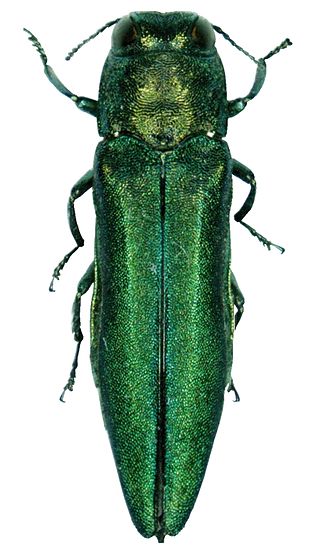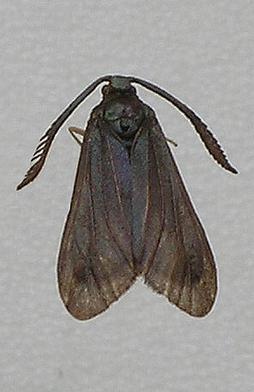
Biological control or biocontrol is a method of controlling pests, whether pest animals such as insects and mites, weeds, or pathogens affecting animals or plants by using other organisms. It relies on predation, parasitism, herbivory, or other natural mechanisms, but typically also involves an active human management role. It can be an important component of integrated pest management (IPM) programs.

Lymantria dispar, also known as the gypsy moth or the spongy moth, is an Eurasian species of moth in the family Erebidae. Lymantria dispar is subdivided into several subspecies, with subspecies such as L. d. dispar and L. d. japonica being clearly identifiable without ambiguity. Lymantria dispar has been introduced to several continents and is now found in Europe, Africa, Asia, North America and South America. The polyphagous larvae live on a variety of deciduous and coniferous trees and can cause severe damage in years of mass reproduction. Due to these features, Lymantria dispar is listed among the world's 100 worst invasive alien species.

Sawflies are the insects of the suborder Symphyta within the order Hymenoptera, alongside ants, bees, and wasps. The common name comes from the saw-like appearance of the ovipositor, which the females use to cut into the plants where they lay their eggs. The name is associated especially with the Tenthredinoidea, by far the largest superfamily in the suborder, with about 7,000 known species; in the entire suborder, there are 8,000 described species in more than 800 genera. Symphyta is paraphyletic, consisting of several basal groups within the order Hymenoptera, each one rooted inside the previous group, ending with the Apocrita which are not sawflies.

The emerald ash borer, also known by the acronym EAB, is a green buprestid or jewel beetle native to north-eastern Asia that feeds on ash species. Females lay eggs in bark crevices on ash trees, and larvae feed underneath the bark of ash trees to emerge as adults in one to two years. In its native range, it is typically found at low densities and does not cause significant damage to trees native to the area. Outside its native range, it is an invasive species and is highly destructive to ash trees native to Europe and North America. Before it was found in North America, very little was known about emerald ash borer in its native range; this has resulted in much of the research on its biology being focused in North America. Local governments in North America are attempting to control it by monitoring its spread, diversifying tree species, and through the use of insecticides and biological control.

The winter moth is a moth of the family Geometridae. It is an abundant species in Europe and the Near East and a famous study organism for evaluating insect population dynamics. It is one of very few lepidopterans of temperate regions in which adults are active in late autumn and early winter. The adults use endothermy for movement in these cold temperatures. The females of this species are virtually wingless and cannot fly, but the males are fully winged and fly strongly. After the initial frosts of late fall, the females emerge from their pupae, walk to and up trees and emit pheromones in the evening to attract males. After fertilization, they ascend to lay, on average, around 100 eggs each. Typically, the larger the female moth is, the more eggs she lays.

Trichogramma is a genus of minute polyphagous wasps that are endoparasitoids of insect eggs. Trichogramma is one of around 80 genera from the family Trichogrammatidae, with over 200 species worldwide.

Choristoneura fumiferana, the eastern spruce budworm, is a species of moth of the family Tortricidae native to the eastern United States and Canada. The caterpillars feed on the needles of spruce and fir trees. Eastern spruce budworm populations can experience significant oscillations, with large outbreaks sometimes resulting in wide scale tree mortality. The first recorded outbreaks of the spruce budworm in the United States occurred in about 1807, and since 1909 there have been waves of budworm outbreaks throughout the eastern United States and Canada. In Canada, the major outbreaks occurred in periods circa 1910–20, c. 1940–50, and c. 1970–80, each of which impacted millions of hectares of forest. Longer-term tree-ring studies suggest that spruce budworm outbreaks have been recurring approximately every three decades since the 16th century, and paleoecological studies suggest the spruce budworm has been breaking out in eastern North America for thousands of years.

The levuana moth is an extinct species of moth in the family Zygaenidae. It is monotypic within the genus Levuana.

Hyblaea puera, the teak defoliator, is a moth and cryptic species complex native to South Asia and South-east Asia. It was first described by Pieter Cramer in 1777. The species has also been recently reported to be present in Central America and Africa. The caterpillar feeds on teak and other trees. It is considered to be one of the major teak pests around the world.

Operophtera fagata, the northern winter moth, is a moth of the family Geometridae. It is widespread through much of Europe.
There are various disparate groups of wingless insects. Apterygota are a subclass of small, agile insects, distinguished from other insects by their lack of wings in the present and in their evolutionary history. They include Thysanura . Some species lacking wings are members of insect orders that generally do have wings. Some do not grow wings at all, having "lost" the possibility in the remote past. Some have reduced wings that are not useful for flying. Some develop wings but shed them after they are no longer useful. Other groups of insects may have castes with wings and castes without, such as ants. Ants have alate queens and males during the mating season and wingless workers, which allows for smaller workers and more populous colonies than comparable winged wasp species.

The gypsy moth, also known as the spongy moth, was introduced in 1868 into the United States by Étienne Léopold Trouvelot, a French scientist living in Medford, Massachusetts. Because native silk-spinning caterpillars were susceptible to disease, Trouvelot imported the species in order to breed a more resistant hybrid species. Some of the moths escaped, found suitable habitat, and began breeding. The gypsy moth is now a major pest of hardwood trees in the Eastern United States.

Aleurocanthus woglumi is a species of whitefly in the family Aleyrodidae. It is a pest of citrus crops, and is commonly known as the citrus blackfly because of its slate-blue colour. It originated in Asia, but has spread to other parts of the world. The parasitic wasps, Encarsia perplexa and Amitus hesperidum can help control the pest.

Cyzenis albicans is a species of fly in the family Tachinidae. A parasitoid, it lays its eggs on leaves of oak, maple, birch and other trees, so that when the leaves are consumed by the larvae of the host winter moth, the eggs hatch inside the larvae. The fly is native to Europe and Asia but has been introduced into North America as a biological control agent of the invasive winter moth.

Compsilura concinnata is a parasitoid native to Europe that was introduced to North America in 1906 to control the population of an exotic forest, univoltine, spongy moth named Lymantria dispar. It is an endoparasitoid of larvae and lives with its host for most of its life. Eventually the parasitoid ends up killing the host and occasionally eating it. It attacks over 200 host species, mainly insects from the Orders: Coleoptera, Lepidoptera and Hymenoptera. Since this parasite has the ability to attack many different types of hosts, the organism has spilled over from the intended forest systems into other areas, like agricultural fields, affecting cabbage pests including the cabbage looper (Trichoplusia); the cabbage worm ; and even other invasive species such as the brown-tail moth. However, it also attacks native, non-pest insects such as the Cecropia moth and American moon moth.

Lymantria dispar dispar or LDD moth, commonly known as the gypsy moth, European gypsy moth, North American gypsy moth, or spongy moth, is a species of moth in the family Erebidae that is of Eurasian origin. It has a range that extends over Europe, Africa, and North America.
The Coconut black headed caterpillar, is a species of moth found in throughout East Asian countries including Bangladesh, India, Sri Lanka, Myanmar, as well as Indonesia. It is considered a pest of coconut palm trees, causing considerable damage to the trees, and reducing the plant's yield significantly and can be a major problem where coconuts contribute to the economy. The species exists on coconut palms through its life stages from larval to moth, and utilizes the tree fronds as a main source of nutrition. Various methods of control have been explored, yet the primary control method is the administration of pesticides directly to the root of the coconut palms.
Anaphes nitens is a species of fairyfly, a chalcid wasp in the family Mymaridae. Native to Australia, it is an egg parasitoid of the gum tree snout beetle, a pest of Eucalyptus trees, and has been used in biological pest control of that species.
Lathrolestes ensator is a species of wasp in the family Ichneumonidae. it is a parasitoid of the apple sawfly Hoplocampa testudinea. Both insects are native to Europe, but the sawfly has been accidentally introduced into North America where it has become established. The larvae of the sawfly tunnel into developing apple fruitlets which later fall to the ground, where the larvae continue their development. The wasp parasitises the larvae and has been released in North America as part of a biological control programme for the sawfly.

Cratichneumon culex is a species of the parasitic wasp of the family Ichneumonidae. The species was first described by Müller in 1776.
















